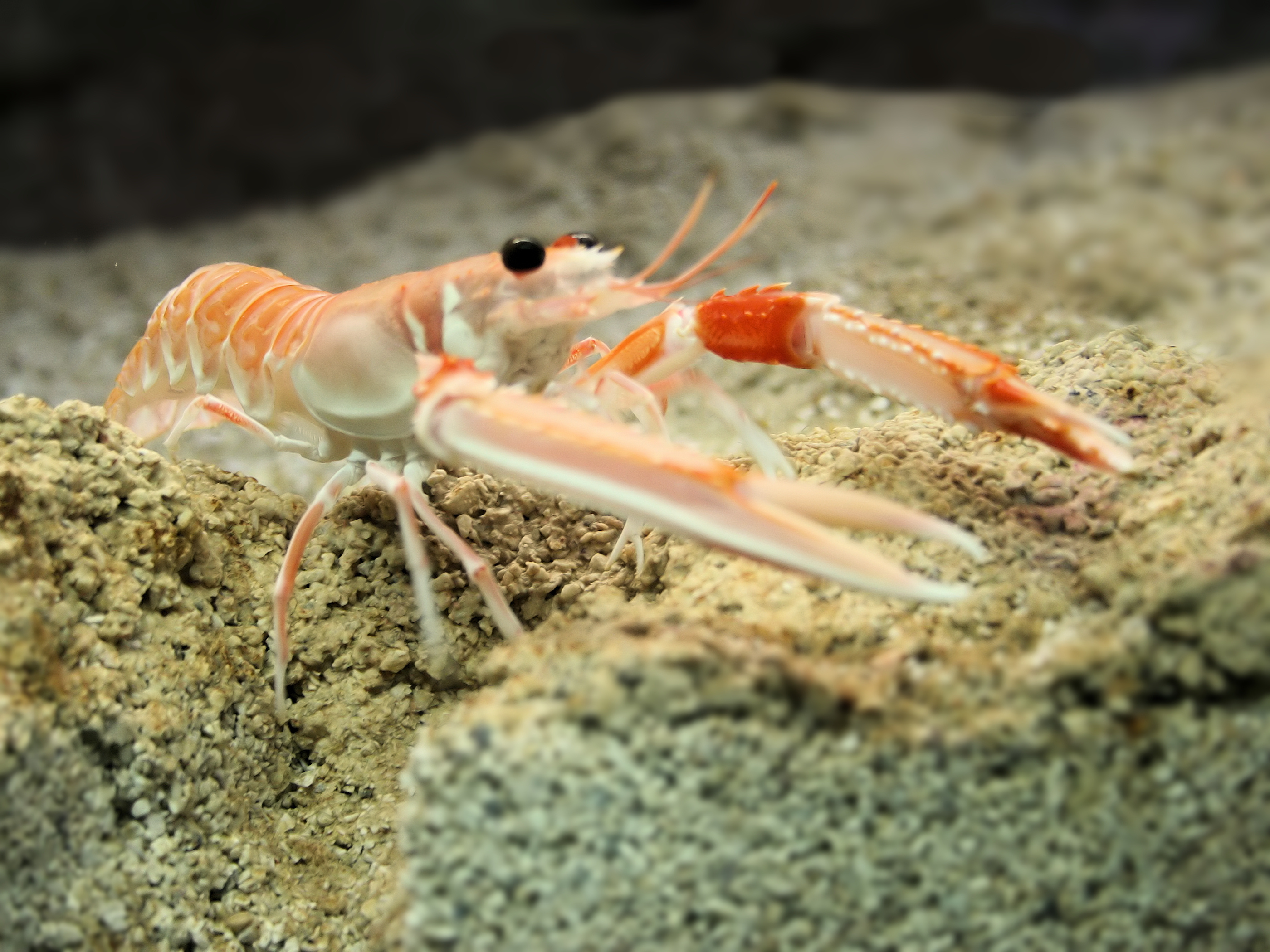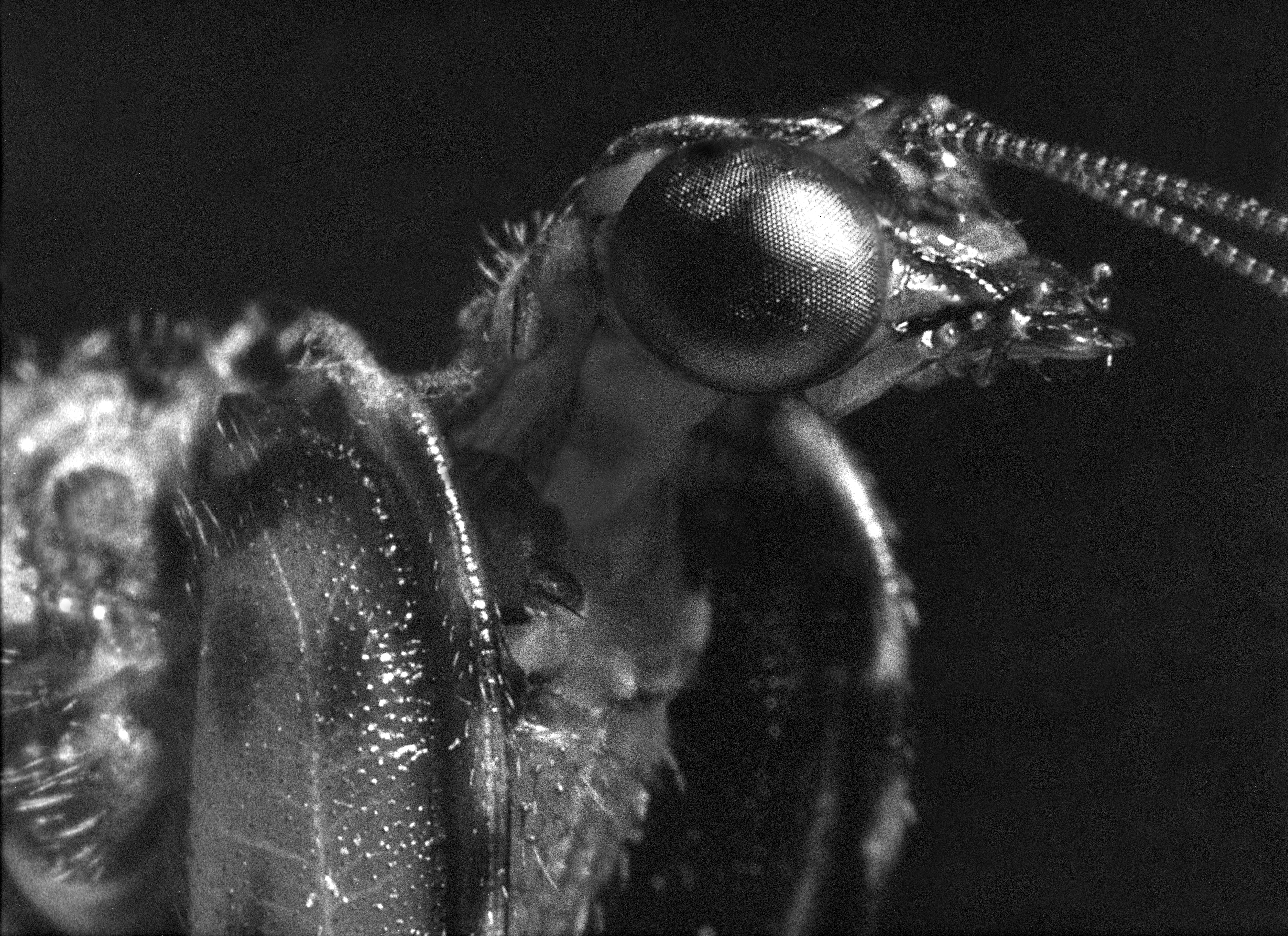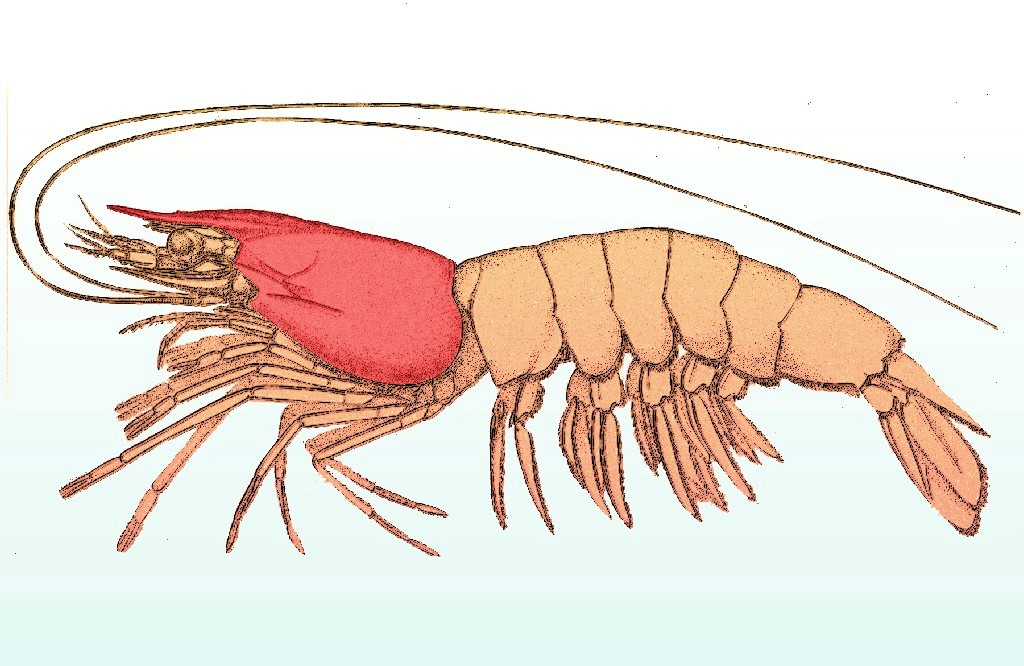|
Langoustines
''Nephrops norvegicus'', known variously as the Norway lobster, Dublin Bay prawn, ' (compare langostino) or ''scampi'', is a slim, coral-colored lobster that grows up to long, and is "the most important commercial crustacean in Europe". It is now the only extant species in the genus '' Nephrops'', after several other species were moved to the closely related genus ''Metanephrops''. It lives in the north-eastern Atlantic Ocean, and parts of the Mediterranean Sea, but is absent from the Baltic Sea and Black Sea. Adults emerge from their burrows at night to feed on worms and fish. Description ''Nephrops norvegicus'' has the typical body shape of a lobster, albeit narrower than the larger-bodied genus ''Homarus''. It is pale orange in colour, and grows to a typical length of , or exceptionally long, including the tail and claws. A carapace covers the animal's cephalothorax, while the abdomen is long and segmented, ending in a broad tail fan. The first three pairs of legs bear cl ... [...More Info...] [...Related Items...] OR: [Wikipedia] [Google] [Baidu] |
Langostino
''Langostino'' is a word of Spanish origin commonly applied to various types of crustacean. “Langostino” is the Spanish diminutive of '( spiny lobster), which comes from the Latin for locust. In the United States, it is commonly used in the restaurant trade to refer to the meat of squat lobsters, which are not true lobsters but are more closely related to porcelain and hermit crabs. Also, langostinos are sometimes confused with Norway lobster, also called langoustines. In the US, the Food and Drug Administration allows "langostino" to be used as a market name for three species of squat lobster in the family Galatheidae: '' Cervimunida johni'', '' Munida gregaria'', and '' Pleuroncodes monodon''. In Spain and Venezuela, it means some species of prawns. In Cuba and other Spanish-speaking Caribbean islands, the name langostino is also used to refer to crayfish, which are freshwater species. In Argentina the name is used to refer to '' Pleoticus muelleri'', a kind of shrimp, ... [...More Info...] [...Related Items...] OR: [Wikipedia] [Google] [Baidu] |
Carl Linnaeus
Carl Linnaeus (23 May 1707 – 10 January 1778), also known after ennoblement in 1761 as Carl von Linné,#Blunt, Blunt (2004), p. 171. was a Swedish biologist and physician who formalised binomial nomenclature, the modern system of naming organisms. He is known as the "father of modern Taxonomy (biology), taxonomy". Many of his writings were in Latin; his name is rendered in Latin as and, after his 1761 ennoblement, as . Linnaeus was the son of a curate and was born in Råshult, in the countryside of Småland, southern Sweden. He received most of his higher education at Uppsala University and began giving lectures in botany there in 1730. He lived abroad between 1735 and 1738, where he studied and also published the first edition of his ' in the Netherlands. He then returned to Sweden where he became professor of medicine and botany at Uppsala. In the 1740s, he was sent on several journeys through Sweden to find and classify plants and animals. In the 1750s and 1760s, he co ... [...More Info...] [...Related Items...] OR: [Wikipedia] [Google] [Baidu] |
Nephrops Norvegicus 1
''Nephrops'' is a genus of lobsters comprising a single extant species, '' Nephrops norvegicus'' (the Norway lobster or Dublin Bay prawn), and several fossil species. It was erected by William Elford Leach in 1814, to accommodate ''N. norvegicus'' alone, which had previously been placed in genera such as ''Cancer'', ''Astacus'' or ''Homarus''. ''Nephrops'' means "kidney eye" and refers to the shape of the animal's compound eye. Although the species in the genus ''Metanephrops'' were previously included in ''Nephrops'', molecular phylogenetics suggests that the two genera are not sister taxa, ''Nephrops'' being more closely related to ''Homarus'' than either is to ''Metanephrops''. Most of the fossil species assigned to the genus ''Nephrops'' are known only from partial remains, and their affinities are not certain. They include: *''Nephrops reedi'' Carter, 1898 – Pliocene, England *''Nephrops costatus'' Rathbun, 1918 – Pleistocene, Panama *''Nephrops maoensis'' Rathbun, 192 ... [...More Info...] [...Related Items...] OR: [Wikipedia] [Google] [Baidu] |
Root (linguistics)
A root (also known as a root word or radical) is the core of a word that is irreducible into more meaningful elements. In morphology, a root is a morphologically simple unit which can be left bare or to which a prefix or a suffix can attach. The root word is the primary lexical unit of a word, and of a word family (this root is then called the base word), which carries aspects of semantic content and cannot be reduced into smaller constituents. Content words in nearly all languages contain, and may consist only of, root morphemes. However, sometimes the term "root" is also used to describe the word without its inflectional endings, but with its lexical endings in place. For example, ''chatters'' has the inflectional root or lemma ''chatter'', but the lexical root ''chat''. Inflectional roots are often called stems. A root, or a root morpheme, in the stricter sense, is a mono-morphemic stem. The traditional definition allows roots to be either free morphemes or bound ... [...More Info...] [...Related Items...] OR: [Wikipedia] [Google] [Baidu] |
Greek Language
Greek (, ; , ) is an Indo-European languages, Indo-European language, constituting an independent Hellenic languages, Hellenic branch within the Indo-European language family. It is native to Greece, Cyprus, Italy (in Calabria and Salento), southern Albania, and other regions of the Balkans, Caucasus, the Black Sea coast, Asia Minor, and the Eastern Mediterranean. It has the list of languages by first written accounts, longest documented history of any Indo-European language, spanning at least 3,400 years of written records. Its writing system is the Greek alphabet, which has been used for approximately 2,800 years; previously, Greek was recorded in writing systems such as Linear B and the Cypriot syllabary. The Greek language holds a very important place in the history of the Western world. Beginning with the epics of Homer, ancient Greek literature includes many works of lasting importance in the European canon. Greek is also the language in which many of the foundational texts ... [...More Info...] [...Related Items...] OR: [Wikipedia] [Google] [Baidu] |
Kidney
In humans, the kidneys are two reddish-brown bean-shaped blood-filtering organ (anatomy), organs that are a multilobar, multipapillary form of mammalian kidneys, usually without signs of external lobulation. They are located on the left and right in the retroperitoneal space, and in adult humans are about in length. They receive blood from the paired renal artery, renal arteries; blood exits into the paired renal veins. Each kidney is attached to a ureter, a tube that carries excreted urine to the urinary bladder, bladder. The kidney participates in the control of the volume of various body fluids, fluid osmolality, Acid-base homeostasis, acid-base balance, various electrolyte concentrations, and removal of toxins. Filtration occurs in the glomerulus (kidney), glomerulus: one-fifth of the blood volume that enters the kidneys is filtered. Examples of substances reabsorbed are solute-free water, sodium, bicarbonate, glucose, and amino acids. Examples of substances secreted are hy ... [...More Info...] [...Related Items...] OR: [Wikipedia] [Google] [Baidu] |
Compound Eye
A compound eye is a Eye, visual organ found in arthropods such as insects and crustaceans. It may consist of thousands of ommatidium, ommatidia, which are tiny independent photoreception units that consist of a cornea, lens (anatomy), lens, and photoreceptor cells which distinguish brightness and color. The image perceived by this arthropod eye is a combination of inputs from the numerous ommatidia, which are oriented to point in slightly different directions. Compared with single-aperture eyes, compound eyes have poor image resolution; however, they possess a very large view angle and the ability to detect fast movement and, in some cases, the Polarization (waves), polarization of light. Because a compound eye is made up of a collection of ommatidia, each with its own lens, light will enter each ommatidium instead of using a single entrance point. The individual light receptors behind each lens are then turned on and off due to a series of changes in the light intensity during mov ... [...More Info...] [...Related Items...] OR: [Wikipedia] [Google] [Baidu] |
Rostrum (anatomy)
Rostrum (from Latin ', meaning '':wikt:beak, beak'') is a term used in anatomy for several kinds of hard, beak-like structures projecting out from the head or mouth of an animal. Despite some visual similarity, many of these are Phylogenetics, phylogenetically unrelated structures in widely varying species. Invertebrates * In spiders, the rostrum is a part of the mouth of which it borders the opening in front. Homologous of an upper lip, this outgrowth is especially characterised by the presence of a pocket-shaped secreting organ, the rostral gland, only accessible by the sole means of histology and electron microscopy (external link "archentoflor"). * In crustaceans, the rostrum is the forward extension of the carapace in front of the eyes. It is generally a rigid structure, but can be connected by a hinged joint, as seen in Leptostraca. * Among insects, the rostrum is the name for the piercing insect mouthparts, mouthparts of the order Hemiptera as well as those of the snow s ... [...More Info...] [...Related Items...] OR: [Wikipedia] [Google] [Baidu] |
Antenna (biology)
An antenna (plural: antennae) is one of a pair of appendages used for Sensory system, sensing in arthropods. Antennae are sometimes referred to as ''feelers''. Antennae are connected to the first one or two Segmentation (biology), segments of the arthropod head. They vary widely in form but are always made of one or more jointed segments. While they are typically sensory organs, the exact nature of what they sense and how they sense it is not the same in all groups. Functions may variously include sensing tactition, touch, air motion, heat, vibration (sound), and especially insect olfaction, smell or gustation, taste. Antennae are sometimes modified for other purposes, such as mating, brooding, swimming, and even anchoring the arthropod to a substrate (biology), substrate. Larval arthropods have antennae that differ from those of the adult. Many crustaceans, for example, have free-swimming larvae that use their antennae for swimming. Antennae can also locate other group members i ... [...More Info...] [...Related Items...] OR: [Wikipedia] [Google] [Baidu] |
Spine (zoology)
In a zoological context, spines are hard, needle-like anatomical structures found in both vertebrate and invertebrate species. The spines of most spiny mammals are modified hairs, with a spongy center covered in a thick, hard layer of keratin and a sharp, sometimes barbed tip. Occurrence Mammals Spines in mammals include the prickles of hedgehogs, and among rodents, the quills of porcupines (of both the New World and the Old), as well as the prickly fur of spiny mice, spiny pocket mice, and of species of spiny rat. They are also found on afrotherian tenrecs of the family Tenrecinae (hedgehog and streaked tenrecs), marsupial spiny bandicoots, and on echidnas (a monotreme). An ancient synapsid, ''Dimetrodon'', had extremely long spines on its backbone that were joined together with a web of skin that formed a sail-like structure. Many mammalian species, like cats and fossas, also have penile spines. The Mesozoic eutriconodont mammal '' Spinolestes'' already displa ... [...More Info...] [...Related Items...] OR: [Wikipedia] [Google] [Baidu] |
Cephalothorax
The cephalothorax, also called prosoma in some groups, is a tagma of various arthropods, comprising the head and the thorax fused together, as distinct from the abdomen behind. (The terms ''prosoma'' and ''opisthosoma'' are equivalent to ''cephalothorax'' and ''abdomen'' in some groups. The terms ''prosoma'' and ''opisthosoma'' may be preferred by some researchers in cases such as arachnids, where there is neither fossil nor embryonic evidence animals in this class have ever had separate heads and thoraxes, and where the ''opisthosoma'' contains organs atypical of a true ''abdomen'', such as a heart and respiratory organs.) The word ''cephalothorax'' is derived from the Greek words for head (, ') and thorax (, '). This fusion of the head and thorax is seen in chelicerates and crustaceans; in other groups, such as the Hexapoda (including insect Insects (from Latin ') are Hexapoda, hexapod invertebrates of the class (biology), class Insecta. They are the largest group w ... [...More Info...] [...Related Items...] OR: [Wikipedia] [Google] [Baidu] |
Carapace
A carapace is a dorsal (upper) section of the exoskeleton or shell in a number of animal groups, including arthropods, such as crustaceans and arachnids, as well as vertebrates, such as turtles and tortoises. In turtles and tortoises, the underside is called the plastron. In botany, a carapace refers to the hard outer cover of a seed which protects the inner embryo. Crustaceans In crustaceans, the carapace functions as a protective cover over the cephalothorax (i.e., the fused head and thorax, as distinct from the abdomen behind). Where it projects forward beyond the eyes, this projection is called a rostrum. The carapace is calcified to varying degrees in different crustaceans. Zooplankton within the phylum Crustacea also have a carapace. These include Cladocera, ostracods, and isopods, but isopods only have a developed "cephalic shield" carapace covering the head. Arachnids In arachnids, the carapace is formed by the fusion of prosomal tergites into a single pl ... [...More Info...] [...Related Items...] OR: [Wikipedia] [Google] [Baidu] |






